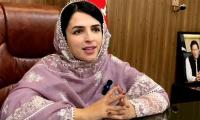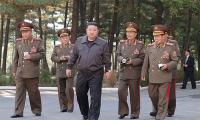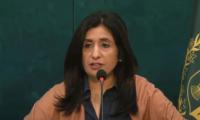Pakistan’s stocks began trading this week with a thumbs-down view of the economic policies of Prime Minister Shehbaz Sharif’s government, in a clear rebuke of the recently installed ruling coalition in Islamabad.
On Monday, share prices fell about three per cent on the very first working day of the week after last Friday’s budget, marking more than just a kneejerk reaction. The trend signaled the overall sentiment across Pakistan notably among businessmen, as Sharif and other members of his ruling coterie pretended ‘all is well’.
But many Pakistanis are sceptical – and for good reason. The budget was presented with promises of bringing a brighter future even in the midst of a worsening economy. Across the country, however, Pakistanis have ample reason to remain deeply suspicious over two inter-related realities.
On the one hand, the state of politics has landed in disarray mainly due to the very evident disconnect between Pakistan’s ruling elite and constituents across the grassroots. Consequently, many constituents feel marginalized and unrepresented. Year after year, mainstream Pakistanis have been widely disappointed as they have witnessed the increasingly powerful reality of elected representatives overseeing policies just in favor of the vested interests surrounding them.
Though promises have been made repeatedly to undertake new initiatives in the name of the people of Pakistan, little has been done by way of actual progress. Among the allocations announced in this year’s budget, the government set aside Rs20 billion for Karachi’s K-4 water project, which first came to the limelight in 2011. The eleven-year delay in launching what is clearly a fundamental need for citizens of Pakistan’s largest city, caused its cost to shoot up to an estimated Rs150 billion or six times the estimated cost of Rs25 billion, estimated more than a decade ago.
On the other hand, Pakistan’s worsening economic conditions have consistently undermined the interests of its mainstream population as successive regimes have largely pursued their carefully chosen ends to benefit a range of individuals and groups tied to them. Though this year's budget from Islamabad has been presented as one meant to tighten the noose around Pakistan’s financial elite, nothing could be further from the truth. Measures such as higher taxes on imported luxury cars or higher taxes on ownership of second homes above a certain value can just not be characterized as even mildly back breaking for the sufficiently endowed. Meanwhile, the budgetary measures have shown little evidence of more than just half-hearted action to lift the fate of government provided hospitals or educational institutions.
Perhaps the biggest economic disconnect between the ruling elite and Pakistan’s mainstream population came in the form of the target for average inflation for the next financial year. Set at a modest rate of just 11.5 per cent, the target for inflation clearly defies logic. At a time when the cost of petroleum, gas and electricity is set to rise anywhere between one-third to roughly by half, Pakistan’s mainstream population is about to bear the worst brunt of inflation in years. Exactly how inflation over the next twelve months will be lower than inflation in today’s Pakistan remains blatantly unclear.
With Pakistan’s political and economic outlook remaining so uncertain, the way forward can only be exceedingly uncertain. The Sharif-led ruling structure faces the challenge of justifying their push in spring this year that led to former prime minister Imran Khan’s downfall. Anecdotal evidence today suggests that Pakistanis feel much worse off than under their previous government. And with elections due no later than next summer, it is hard to imagine the government beginning to make hard choices in the best interest of Pakistan.
Going forward, Pakistan’s outlook will likely remain a victim to the failure of its rulers. Sharif and others in the ruling coalition have frequently promised to lead Pakistan towards a far more promising future than what was possible under the Khan government. But their failure to read the writing on the wall could cost Pakistan dearly.
The crisis for Pakistan’s middle and low-income consumers witnessed today is surely acute. Its intensity easily outpaces the challenging times ever faced in the nation’s history. While the post-9/11 security crisis was intense, the cushioning effect came from generous US-led Western assistance that helped protect Pakistan’s mainstream households from hard economic trends. Today, adverse global circumstances have underlined a tough reality: that Pakistan must finally fix its multiple homegrown challenges, long ignored under successive governments.
Ironically though, Pakistan’s present-day economic policies are led primarily with the intention of returning to a resumption of the IMF’s loan while making the country appear solvent. Yet, those two goals will be hard to achieve unless backed by the fundamentally vital goal – that without resolving unprecedented challenges faced by Pakistan’s mainstream population, sustaining an economic recovery for the long term will just not happen.
The writer is an Islamabad-based journalist who writes on political and economic affairs. He can be reached at: farhanbokhari@gmail.com
Over-arching US strategic goal since end of cold war has been to ensure its continued global hegemony
‘Anonymisers’, such as VPNs and Tor Project, hide the identity of a user on the internet
Heatwaves scorched East Africa and South Asia, while flash floods in Spain took over 220 lives
Prominent feature of this year's Ideas Expo was unveiling of state-of-the-art unmanned warship
Pakistani men wield enormous influence over many aspects of women's lives resulting in notable power in shaping...
PTI is most popular party in Punjab and KP, despite its leader, Imran Khan, being incarcerated in Adiala Jail







